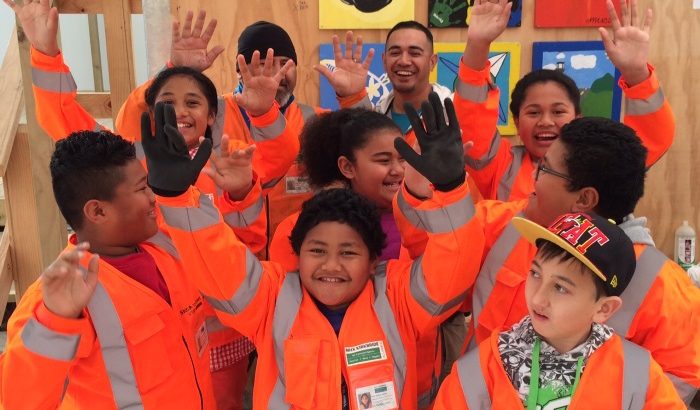Nueva Zelanda/ Abril 2016/portal Education.govt.nz
Resumen: Un grupo de estudiantes de una escuela primaria de Auckland, han descubierto de primera mano cómo lo que aprenden en la escuela se puede aplicar en la vida real. Ocho estudiantes de la Escuela regular Central de Mangere, puso en su alta visibilidad chalecos fluorescentes para el proyecto de construcción de carreteras cerca.
A group of students from an Auckland primary school have found out firsthand how what they learn in school can be applied in real life.
Eight Mangere Central School students regularly put on their hi-vis fluorescent jackets and head to a nearby road construction project.
They join the other workers in line for bacon and eggs, have decorated the lunch room with their works of art and are set to lend a hand planting thousands of trees.
The student’s efforts are part of a special partnership between Mangere Central School and the redevelopment of State Highway 20A in Auckland.
Principal Maria Heron says when she first heard about the road upgrade she was worried about possible disruptions to school life.
But after talking to the project’s NZ Transport Agency stakeholder manager, Kelli Sullivan, the pair came up with a plan to get the school community involved.
«Right from the start, when NZ Transport Agency came to talk to us about the project, Kelli and I have worked closely together to make something positive of the disruption,» Maria says.
«NZ Transport Agency got involved in the school’s strategic vision and how they could fit in with it, which threw up a lot of opportunities for us.»
Kelli says she and Maria wanted to create exciting learning opportunities for students at Mangere Central.
Last year the school planned a lot of its curriculum around physical structures, bridges and infrastructure, so Maria says working on the highway project ‘ticked all the boxes’ in providing authentic learning opportuinities.
Eight students in particular have been readily involved in the project. Kelli says students were given the chance to apply for a job on site and were paired-up with a fully grown counterpart – from a mini health and safety officer to a mini construction manager.
«The students were inducted onto the site and given their own photo identification cards,» Kelli says. “They are given specific monthly tasks, for example the stakeholder manager helped work on a neighbourhood barbeque to discuss the project with the community.
«The children love being involved. They have all gone from being shy and quiet to fitting right in with the rest of the team, they are great ambassadors for their school and community.»
Kelli says the workers on site enjoy having the students around.
«They love it. To be honest I think that our workers get more out of it than the kids. For them it is like having their own children on site.»
Because the students are under 18 there are strict health and safety rules when they are on site. As part of the project team the students have supervised access to site offices but are not allowed in construction areas. Luckily, due to the scale of the project, there are many vantage points and opportunities to interact directly with the workers.
Maria says both sides have tried to be good neighbours to each other and help each other in their work as much as they can
«They’ve helped us out a few times,” she says. “We were putting in a new garden so they sent over a few guys to put the boxing in for us. It was fantastic.»
«On another occasion the workers discovered eels in an old drain. They stopped work and students were involved in the process of trapping and re-homing the eels in accordance with local iwi protocol.»
Being involved in the project has shown the students many different career pathways, Maria says.
«One boy, who applied to be a mini-engineer, went up to one of the real engineers and said ‘I really like Lego, can I be an engineer?’. He turned around and said ‘that’s how I became one’.»
A lasting legacy of the partnership will be a man-made wetland across the road from the school, which students will help develop. After the project is complete the students will be the kaitiaki of this wetland.
Kelli says partnering up with stakeholders and being a good neighbour is something the NZ Transport Agency strives for on all their projects.
«The SH20A team are incredibly fortunate to be working right beside a school.»
Fuente: http://www.education.govt.nz/news/mangere-central-school-pitch-in-on-roading-project/
Foto: http://www.education.govt.nz/assets/Images/News-items/2016/MangereCentralPhoto1.jpg









 Users Today : 9
Users Today : 9 Total Users : 35460218
Total Users : 35460218 Views Today : 12
Views Today : 12 Total views : 3418907
Total views : 3418907